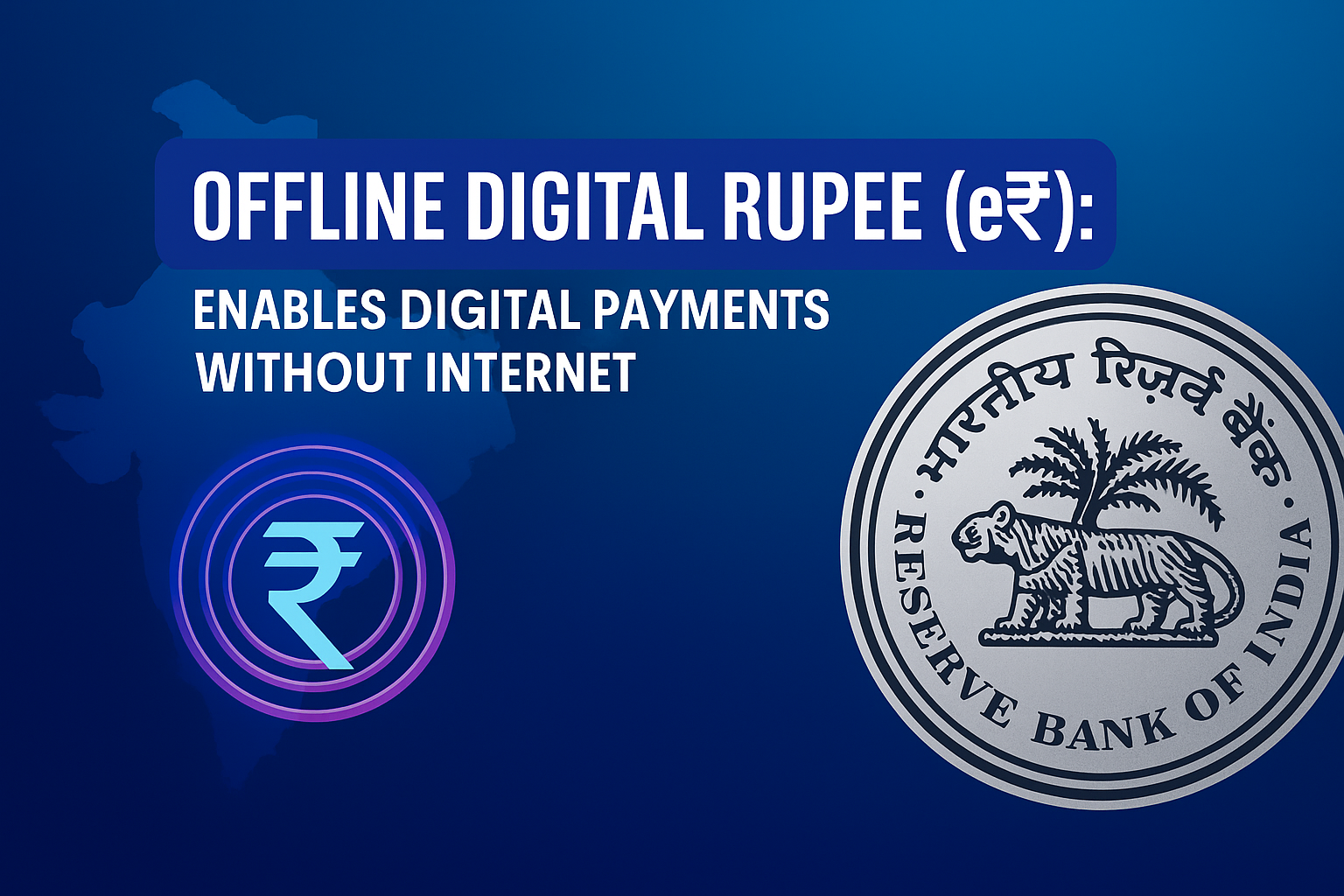Introduction
In a landmark move, the Reserve Bank of India (RBI) has unveiled the Offline Digital Rupee (e₹) — a version of India’s central bank digital currency (CBDC) that enables users to transact even without internet connectivity. This development signals a shift in how digital money can function, especially in remote or underserved regions. In this article, we’ll explore how the offline e₹ works, its benefits and challenges, and what it means for marketers, fintech firms, and the future of payments.
What Is the Digital Rupee (e₹)?
- The e₹ is India’s Central Bank Digital Currency (CBDC) — a digital equivalent of the physical rupee, issued directly by RBI.
- It functions like digital cash: you can hold it in a wallet, send/receive, and make payments.
- It differs from UPI: UPI is a payment system that moves money between bank accounts, while e₹ is itself the money stored in the wallet.
- The e₹ pilot has been live since December 2022 in a retail context and also in wholesale form.
What’s New: The Offline Feature
Why “offline” matters
Traditional digital payments (UPI, cards, wallets) require active internet or connectivity. In many rural or remote parts of India, connectivity is patchy or non-existent. The offline e₹ bridges that gap — making digital payments mimic physical cash usability.
How offline e₹ works
There are two main approaches being explored:
- Minimal network / telecom-assisted
Transactions may require only a faint mobile network signal (not full internet) to authenticate or sync. - NFC “tap & pay” mode
Using Near Field Communication (NFC), users can tap their device to another device to transfer e₹ without any internet or telecom signal at all.
These offline transactions settle instantly between wallets, akin to handing over cash.
Key Features & Differentiators
- No charges, no minimum balance: The e₹ wallets come free of transaction fees and don’t require minimum balances.
- Programmability: Funds can be “programmed” — e.g. limited by time, merchant category, location, or usage. This enables more targeted subsidies, conditional transfers, or corporate use cases.
- Interoperability with UPI: The e₹ wallet supports scanning existing UPI QR codes, enabling merchants who already accept UPI to also accept e₹.
- Change handling: If you pay an amount smaller than your e₹ “note,” the system handles change automatically back to your wallet.
Benefits & Potential Impact
Financial inclusion in remote areas
Offline e₹ enables people in connectivity-impoverished regions to participate in the digital economy — it’s digital cash for places with no internet.
Cost efficiency & infrastructure savings
By reducing dependency on intermediaries, payment gateways, and network costs, offline e₹ can reduce transaction costs in the long run.
Programmable money & targeted subsidies
Governments and corporates can use e₹’s programmability to restrict usage (for e.g. agriculture subsidies only at agri-stores), reduce leakage, or time-limit benefits.
Boost to digital adoption & trust
Offline functionality lowers the barrier to adoption. If users can trust it works everywhere (like cash), they may embrace e₹ more readily.
Challenges & Considerations
- Security, fraud & double-spending risk
Offline systems must guard against duplicating or forging transactions. Ensuring tamper-proof wallets is critical. - Scalability & infrastructure costs
The underlying systems, wallets, synchronization protocols, and fallback systems must scale as usage grows. - User interface & experience
Wallet apps must be extremely user-friendly, multilingual, low-power, and intuitive — especially for rural users. - Regulation, privacy & data protection
Balancing traceability (for compliance) with privacy (for cash-like anonymity) is delicate. - Merchant/merchant device adoption
For NFC or proximity payments, merchants need the appropriate hardware or software upgrades. - Interoperability with existing rails
Ensuring smooth fallback or bridging with UPI, legacy banking, and other payment systems is crucial. - Acceptance & trust
Convincing users and businesses to adopt e₹ over well-entrenched alternatives will need incentives, education, and trust-building.
Marketing & Business Implications
- Early mover advantage for fintechs
Fintech firms, especially in rural or niche verticals (agri-tech, microfinance, micro-merchants), can leverage offline e₹ to offer differentiated solutions. - Merchant adoption campaigns
Marketing, training, and subsidised hardware for merchants will be key to widespread uptake. - Use-case innovation
Think of loyalty programs, time-bound discounts, micro-loans, gamification tied to e₹ balances — possibilities expand with programmability. - Partnerships
Collaborations between banks, telecom providers, device manufacturers, and retailers can drive faster scale. - Content & educational campaigns
Clear, trust-building content explaining “how offline works,” “safety,” “benefits” will be essential for mass adoption.
What’s Next & Way Forward
- The RBI has already expanded access, launching a retail sandbox to allow fintechs to experiment with e₹, opening up beyond just banks.
- To make e₹ more acceptable, focus areas include standardization, regulatory clarity, wallet design, and privacy frameworks.
- Over time, cross-border CBDC pilots may also be explored using e₹ rails.
- Success will depend on trust, consistent use cases, and integration into everyday life.
Conclusion
The launch of Offline Digital Rupee (e₹) marks a major evolution in India’s payment landscape. By combining the benefits of digital currency with offline usability, it bridges the gap between cash and digital payments. For marketers, fintech players, and businesses, this is a fresh frontier — from new product ideas to deeper reach in untapped segments. The journey will not be simple, but the potential is tremendous.
If you like, I can also generate a shorter “Explainer” post or infographic version of this blog for your audience. Want me to prepare that?
Leave a comment
Your email address will not be published. Email is optional. Required fields are marked *










